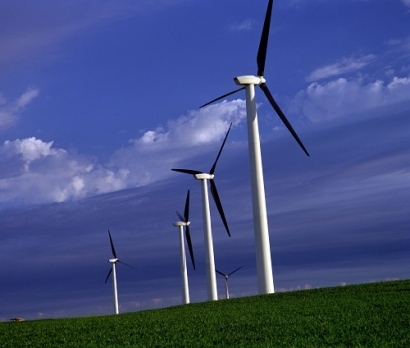
But is wind energy practical for your particular property? To determine whether to implement wind power, there are a number of different aspects you'll need to consider.
Arguably, the most important determining factor in deciding whether wind energy is right for you is location. Of course, turbines work well in wide-open spaces like the countryside and are a viable option for those looking for an alternative option to stringing powerlines out into the wilderness. Here wind farms are most prevalent and often located on top of hills, unhindered by trees, land or buildings so as to capture the most wind.
But wind turbines can also generate power in urban areas. Although the roughness of the terrain in urban environments can reduce wind flow compared to a field, urban wind speeds increase with altitude. So, mounting turbines on top of tall buildings may be the perfect opportunity for creating wind power. Consult the DOE Wind Energy Resource Atlas' documentation of regional wind speeds to determine whether or not to place turbines on shorter or residential buildings. In most cases, the annual wind speed must be at least 4 meters per second to install a system.
Another thing to consider is whether your site is more conducive to a stand-alone system or a grid-connected system. Stand-alone wind systems are typically appropriate for residences, farms and communities that are far from utility lines. Without wind power, these sites would have to pay a whopping $15,000 to $50,000 per mile of utility line, depending on the terrain. These independent systems are also ideal for people who want to reduce their environmental impact or desire freedom from power providers.
Grid-connected systems are more conducive to city environments where many people need access to a lot of power at any given time. And, where wind doesn't provide, utilities will make up the difference. Practically any area that receives utility-supplied electricity and averages an annual wind speed of at least 4.5 meters per second can install a grid-connected wind system. This kind of system is ideal for people who live in an area where electricity is expensive and who are comfortable with long-term investments.
But is wind energy a smart investment for your property? While wind power is more expensive than power from fossil-fuel-burning plants, it remains the cheapest form of new electricity generation today. That being said, a small 100-kilowatt turbine may cost $3,00 to $8,00 per kilowatt of capacity. However, a 10-kilowatt machine needed to power a residential home may cost $80,000 or more. A utility-scale wind turbine would cost even more at about $1.2 million to $4 million.
Still, these prices are cheaper than building a power plant. And the wind turbines pay for themselves in just a few years. A 100-megawatt wind farm — which would contain about 50 turbines — generates about $45 to $250 million in annual revenue. So, if each turbine cost $4 million, which is on the high side, and revenue was $250 million, the industry would still make $50 million in a single year.
Of course, this doesn't take into account maintanence costs. But, regardless, wind farms are still seeing a huge ROI just years after installment. So, if you have the money to invest right now and the location is right, investing in wind power truly is a smart choice.

